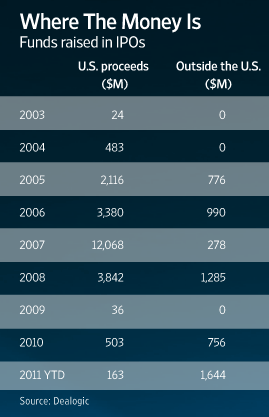HONG KONG (Dow Jones Investment Banker) – The US$1.44 billion IPO and listing in February on the London Stock Exchange of Justice Holdings Ltd. marks something of a revival for special purpose acquisition companies. It raises the question: Why are SPACs yet to make it big in Asia, which last year accounted for more than 54% by volume of IPOs globally? They could do well in Hong Kong in particular.
The Justice deal ranks as the fifth largest IPO globally this year, according to Dealogic. It’s also the largest IPO on the LSE since April 2009, as well as the largest by a UK issuer since 2006. IPOs by SPACs have been in free fall since 2007, when more than US$12 billion was raised, equivalent to 18% of all IPO proceeds in the US that year. But that figure was just below US$1.3 billion in 2010, as a number of vehicles floated in prior years either failed to identify targets, or only did so closer to their redemption dates, sometimes overpaying for acquisitions in the process.

A quick recap. SPACs are blank-check companies that raise funds in an IPO to acquire a business at a later stage, and are sold on the basis of the experience of the management team. Very much a US phenomenon, there have also been a few sizeable IPOs in Germany, Italy and the Netherlands.
SPACs take the form of a combination of shares and warrants, traded either as a unit or separately. The proceeds raised are held in a trust, with usually up to 24 months for management to conduct a merger or acquisition.
Most trade at or below their IPO value until an acquisition is announced.
So far, Korea is the only country in Asia to have actively admitted SPACs to listing, following a change in the rules there. Some 20 SPACs were listed on the KRX in 2010. With an aggregate amount raised of just over US$478 million, most are small, and their development there has also been hindered by punitive domestic tax rules. Malaysia and Singapore have also each introduced frameworks (in 2009 and 2010 respectively) for the listing of SPACs.
However, the most promising market for SPACs in Asia might be Hong Kong, where they could facilitate the listing of Chinese companies and potentially bypass a complex approval process for listing.
They could also provide an exit to private equity players beyond the traditional dual-track routes of M&A and IPOs. Hedge funds and institutions too would welcome such pre-IPO opportunities given the SPACs’ experienced management teams, and with investments closer to their listing venue – at a time when many investors have been losing confidence in Chinese mid-caps listed in the US. through the acquisition of shell companies. That’s not to mention the benefit of potentially lucrative fees for ECM and private bankers.
The biggest obstacle may come from the regulator, the Securities and Futures Commission, which has a track record of dealing carefully with innovative offerings, as it did with the IPO of Russia’s United Co. RUSAL, when it ruled in favor of a very high board lot, effectively barring retail investors from the transaction.
The Stock Exchange of Hong Kong, which lost out to Singapore for the listing of the largest IPO in Asia in 2011 (and so far also globally), the US$5.45 billion offering by Hutchison Port Holdings (HPH Trust), will itself probably be more focused on the listing rules, and on the absence of a track record for these vehicles. However, “backdoor” listings are not unknown in Hong Kong, and many stock exchanges, both in the region and elsewhere, welcome corporates, such as mining explorers, without the requisite three-year history.
In theory, SPACs could have a great future in Hong Kong. In practice, however, one suspects they may not yet receive the focus they perhaps deserve.
(Philippe Espinasse worked as an investment banker in the U.S., Europe and Asia for more than 19 years and now writes and works as an independent consultant in Hong Kong. Visit his website at https://www.ipo-book.com. Readers should be aware that Philippe may own securities related to companies he writes about, may act as a consultant to companies he mentions and may know individuals cited in his articles. To comment on this column, please email [email protected]).
[This article was originally published on Dow Jones Investment Banker on 5 April 2011 and is reproduced with permission. It also appeared on WSJ.com, the website of The Wall Street Journal].
Copyright (c) 2011, Dow Jones & Company, Inc.
